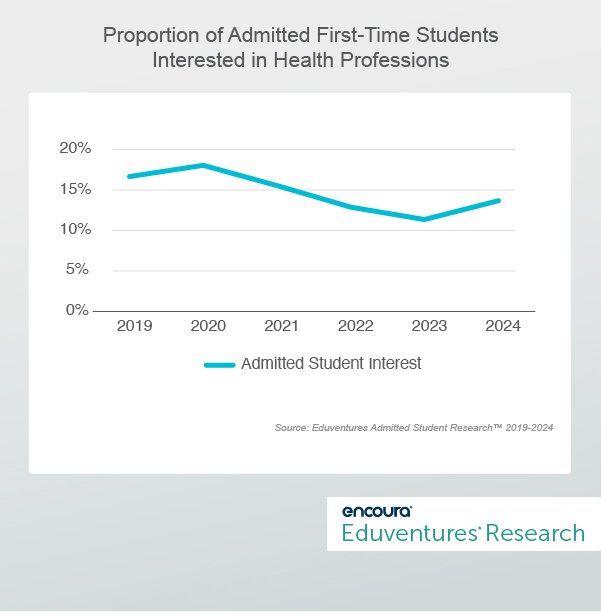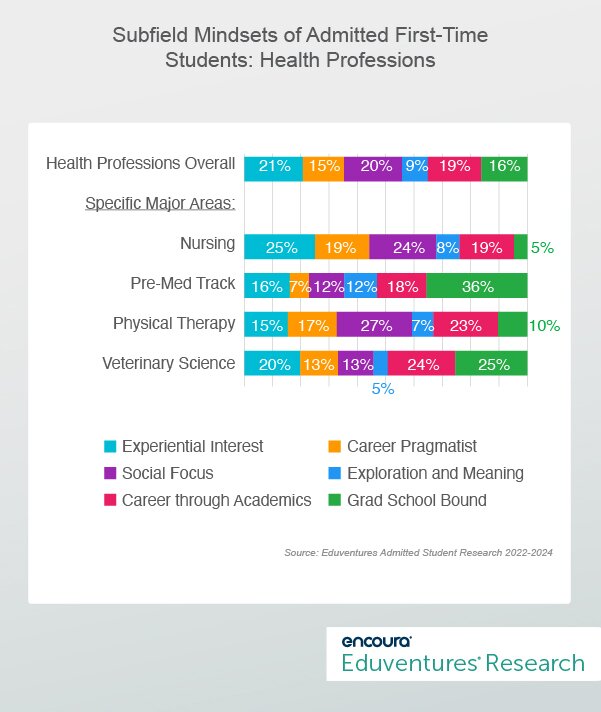Academic interests rise and fall, but Health Professions has stood the test of time, landing it a spot among the “Big Five” academic programs. These five program areas—also including Business, Biology, Computer Science, and Engineering—have dominated the academic interests of admitted students for years.
But even academic giants can experience rocky roads. While the Big Five Fields as a whole have grown in popularity, Health Professions has stumbled. The pandemic shook its footing, resulting in a 24% decrease in its share of admitted student interest since 2020.
After years of uncertainty and discouraging trends, how do students perceive the pursuit of Health Professions today?

Figure 1.
Figure 1 suggests that following three years of steady decline, Health Professions is no longer slumping—increasing its share of interested students by 21% in the most recent year for which data is available. While it’s too soon to say with confidence that Health Professions has made a triumphant return, certainly a year with good news is welcome.
And there are other positive signals. The Eduventures 2025 Prospective Student Brand Research™ also reveals a 16% increase in interest among prospective students when compared to the previous year.
The National Student Clearinghouse’s fall 2024 Current Term Enrollment Estimates reveals that 2024 was the first time the broad field experienced an increase in undergraduate enrollment since the pandemic (8% increase, including four-year undergraduate pathways only).
When we consider what’s on the other side of a degree for students in Health Professions, there is promise too. Lightcast data for both Healthcare Support Occupations and Healthcare Practitioners and Technical Occupations projects job growth from 2024 to 2033 that outpaces the average for all broad fields.
It appears that the Health Professions enrollment pandemic fallout was two-fold:
- Health Professions took center stage as the world faced COVID-19. College students who enrolled in health professions during the pandemic also faced barriers in completing clinical hours or practicum experiences needed to graduate. It’s understandable why young adults would pursue other paths given the heightened media attention and stress health professionals and the industry experienced.
- The pandemic resulted in a disproportionate enrollment dip among students from low-income households, which have historically gravitated to certain Health Professions. And so, while students might have lost interest in Health Professions, the academic area also lost some students who exited the college pipeline.
Emerging data, however, from both National Student Clearinghouse and Common Application’s “First-year Application Trends though March 1” shows growth in low-income students—an encouraging sign for Health Professions and for access.
Meeting Student Motivations
Given these encouraging signs, how can colleges adapt their enrollment strategies to meet the needs of this academic giant? Student Mindsets™ shed light on the motivations and interests of Health Professions students as they make their college choices.
Figure 2 shows the Admitted Student Mindsets of students interested in Health Professions overall, followed by its most popular subfields.

Figure 2.
Figure 2 shows how unique students are within the Health Professions. While other Big Five areas like Business and Biology show more similar Mindset distributions across subfields, Health Professions students are distinct.
- Nursing, which makes up 36% of Health Professions students in Figure 2, has a strong proportion of both Experiential Interest and Social Focus students. This shows how Nursing students focus on their careers by seeking clear pathways through college to career and on a vibrant campus community where they can engage socially.
- Pre-Med or Veterinary Science students, on the other hand, are quite different. These students are predominantly Grad School Bound and Career through Academics, demonstrating their view of college as an important academic steppingstone to graduate school or career. These students may be more focused on academic accolades and opportunities as they approach their college choices.
The Bottom Line
While Health Professions has not matched the stability or growth of the other Big Five Fields since the pandemic, recent data from prospective and current students offers optimism for this academic area—and for the college pipeline overall. And with the demographic cliff at our doorsteps, this slight rebound comes just in time.
The Mindsets highlight the distinct approaches that students pursuing Health Professions take when selecting a college. While it may be tempting to think of Health Professions as a monolith, Student Mindsets provide colleges with a framework to understand and address the varied motivations and preferences of these students during the college search process. This approach enables colleges to engage with prospective students on a deeper level that extends beyond specific academic majors.
For more on this topic… The Eduventures new Admitted Student Trend Report dives into the latest data of the Big Five Fields sharing insights on how institutions can approach the academic giants dominating enrollment.

